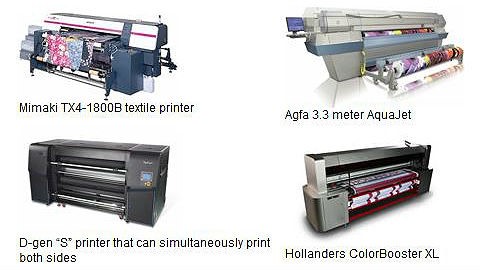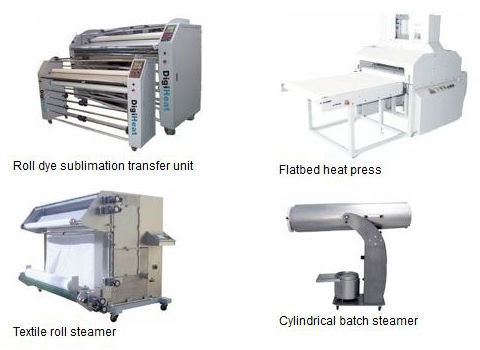Dyes & Pigments
In general terms, dyes are soluble and have an affinity to the substrate they are applied to. Pigments on the other hand are non-soluble and have no affinity to the material they are applied to.
A third category has some characteristics of each of the primary two and is called a dispersed dye.
The binding mechanism of the pigment to the textile and the reaction of the dyes with the fibers usually require a complimentary pretreatment chemistry and/or post treatment to achieve the optimum binding result. For digital printing textiles, the ink, textile and the printing system must be designed to control bleeding while accomplishing the hand (feel), correct color and color fastness required by the intended application. With ink jet printing, pre-heating the textile or the addition of a fabric pretreatment or coating can help control these effects.
Why do we have all of these different textile-dyeing systems?
All fibers are porous to some degree, being comprised of molecules that are either positively or negatively charged. To address these variables, a variety of dyes and treatments have been developed to provide for optimal penetration and dye retention based on the specific properties of each fiber. Using the right combination of dyes and ancillary treatments for each fiber results in better color reproduction and better color fastness properties.
Acid dyes
Acid dyes are best used to print on wool, angora, cashmere, silk and polyamides (nylon), can also be printed using this type of dye. Dyes and the fibers have positively charged ions that are naturally attracted to the acid dyes negatively charged ions. The acid-dye-based ink is printed directly to the textile, and then a steam setting process applies heat. The steaming enhances the attraction between the textile and ink molecules and forms a powerful union between the two. At the end of the steaming process, excess dyes are removed in a rinse or wash stage.
Post processing-steaming, then rinse or wash to remove excess. Markets-Fashion textiles, indoor soft signage
Reactive dyes
Fiber reactive dyes are mainly used to print onto the cellulose-based fibers, Cotton, Linen & Rayon. They are also used to dye nylon, although the fixation process is slightly different. The advantage of this type of colorant over acid dyes is that it is wash fast and durable when used on cotton, producing vibrant colors.
Inkjet printed textiles may also need dye compatible top coatings before printing. Heat is then applied to the printed textile in order to aid the chemical reaction. Excess dyes that did not bond are removed from the fabric through a washing process.
Post processing-steaming, then rinse or wash to remove excess.
Markets-Fashion textiles, indoor soft signage.
Direct Pigments
Pigments are ground into extremely fine powders and suspended in a liquid carrier in order to be used in an inkjet printer. Binders in the liquid carrier facilitate in bonding the pigments to the fibers composition. These inks tend to produce less vibrant and saturated colors and have poor wash fastness properties.
Dispersed Dyes and Dye Sublimation
Used for fibers such as polyester, acetate rayon, poly Lycra and acrylics. The dyes have the ability to form a solid solution with the fiber or dissolve within the fiber and become part of it. Dispersed dyes are typically direct printed on to the textile and then processed through a heat press to fix and develop the color.
A specialized form of dispersed dye has the ability to sublimate (go from a solid state to a gas state). These dyes are used to manufacture dye sublimation inks, and are quite popular. With dye sublimation, the inks are printed on a carrier media, such as paper, and then transferred onto the fabric by applying heat and pressure using a heat press. The sublimation inks can also be directly applied to the material and heat fixated in line. Although there may be some differences in the print characteristics for transfer application versus direct application, it can be argued that direct application is a more sustainable print process in that it eliminates the consumption and disposal of transfer paper. Keep in mind either method requires energy to generate heat to initiate the sublimation of the ink.
In the heat press, the dyes become gas and the synthetic fibers “open” to receive the gas. After the heat is removed, the fibers close, encapsulating the dye that returns to a solid state. Dye sublimation can either be a transfer process or one where printing is direct onto the media. Printing directly onto the fabric increases the spread of the ink (dot gain) and can decrease vibrancy.
Post processing-heat fixation:
Markets-Fashion textile, indoor & outdoor soft signage, home textile (wash fast and durable, not very UV resistant)
Solvent Ink
Solvent inks are acceptable for textile printing for specific uses. The nature of the ink makes these items for display only, not wearable or for use in furniture fabrics. Since the ink sits on the surface of the fabric, there is greater chance of abrasion and scuffing of the image. Solvent inks are also used for manufacturing of temporary carpets for custom floor displays. Most any solvent-based printer can print textiles that are compatible with solvent-based ink systems. Some textiles have coatings that help to control dot spread when printing.
UV Curable Ink
UV curable inks are now used in roll-to-roll printers for the production of printed textiles. Again, these products are for display/exhibition purposes only, not for being worn. The longevity of these prints depends on the environment in which they are displayed. Longevity outdoors would be on par with the solvent ink versions of the same print.
Latex
A variety of fabric types are used for soft signage applications, with polyester currently the most common. Other available fabrics include cotton/polyester blends, satin-finish polyester, and cotton. There are a number of Hp Latex compatible fabrics and textiles available. Certain types of media require a backing paper. Contact your local graphics or textile supplier for more information.
Digital Printer Types
Direct to Textile or Roll-to Roll (Dye sublimation or Textile inks)
There are many direct to textile printers on the market, some with special capabilities that will allow printing of stretch fabrics, other may have heat setting ovens on the take up side. Some printers have adhesive belts that can stabilize stretch materials during transport. Many of the textile printers are setup to print onto sublimation paper that is then transferred to the material of choice during a secondary process. You can use UV curable inks with fabric for display purposes. Adhesion of the ink depends on the nature of the fabric and ink system in use.

Ancillary Equipment
Roll to roll transfer presses are common if sublimation paper is being printed. Steam or heat fixation units are available in many sizes and configurations.
